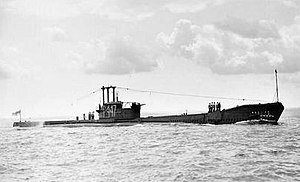|
HMS Astute (P447)
HMS Astute (P447) was an Amphion-class submarine. Her keel was laid down by Vickers at Barrow-in-Furness. She was launched in 1944 and commissioned in 1945.[1] In 1953 she took part in the Fleet Review to celebrate the Coronation of Queen Elizabeth II.[2] Astute was scrapped on 1 October 1970 at Dunston on Tyne. DesignLike all Amphion-class submarines, Astute had a displacement of 1,360 tonnes (1,500 short tons) when at the surface and 1,590 tonnes (1,750 short tons) while submerged. It had a total length of 293 feet 6 inches (89.46 m), a beam length of 22 feet 4 inches (6.81 m), and a draught length of 18 feet 1 inch (5.51 m). The submarine was powered by two Admiralty ML eight-cylinder diesel engines generating a power of 2,150 horsepower (1,600 kW) each. It also contained four electric motors each producing 625 horsepower (466 kW) that drove two shafts.[3] It could carry a maximum of 219 tonnes (241 short tons) of diesel fuel, although it usually carried between 159 and 165 tonnes (175 and 182 short tons).[3] The submarine had a maximum surface speed of 18.5 knots (34.3 km/h; 21.3 mph) and a submerged speed of 8 knots (15 km/h; 9.2 mph).[4] When submerged, it could operate at 3 knots (5.6 km/h; 3.5 mph) for 90 nautical miles (170 km; 100 mi) or at 8 knots (15 km/h; 9.2 mph) for 16 nautical miles (30 km; 18 mi). When surfaced, it was able to travel 15,200 nautical miles (28,200 km; 17,500 mi) at 10 knots (19 km/h; 12 mph) or 10,500 nautical miles (19,400 km; 12,100 mi) at 11 knots (20 km/h; 13 mph).[3] Astute was fitted with ten 21-inch (533 mm) torpedo tubes, one QF 4-inch naval gun Mk XXIII, one Oerlikon 20 mm cannon, and a .303 British Vickers machine gun. Its torpedo tubes were fitted to the bow and stern, and it could carry twenty torpedoes. Its complement was sixty-one crew members.[3] Astute was laid down at Vickers-Armstrongs Barrow-in-Furness shipyard on 4 April 1944, was launched on 30 January 1945 and completed on 30 June 1945.[5] Service historyAstute arrived at Halifax, Nova Scotia on 11 April 1950 for a six-week training period with the Royal Canadian Navy ending on 1 July.[6] Astute spent 21 months in 1955–56 based at Halifax as part of the Canadian submarine squadron, leaving Canada for the UK on 10 December 1956.[7] As a response to the Cuban Missile Crisis, Astute and sister ship Alderney, both part of the Halifax-based 6th Submarine Squadron, were deployed to the North-East of the Grand Banks to warn if Soviet submarines were to be sent across the Atlantic to Cuba.[8] References
Publications
External links |
||||||||||||||||||||||||||||||||||||||||||
Portal di Ensiklopedia Dunia
